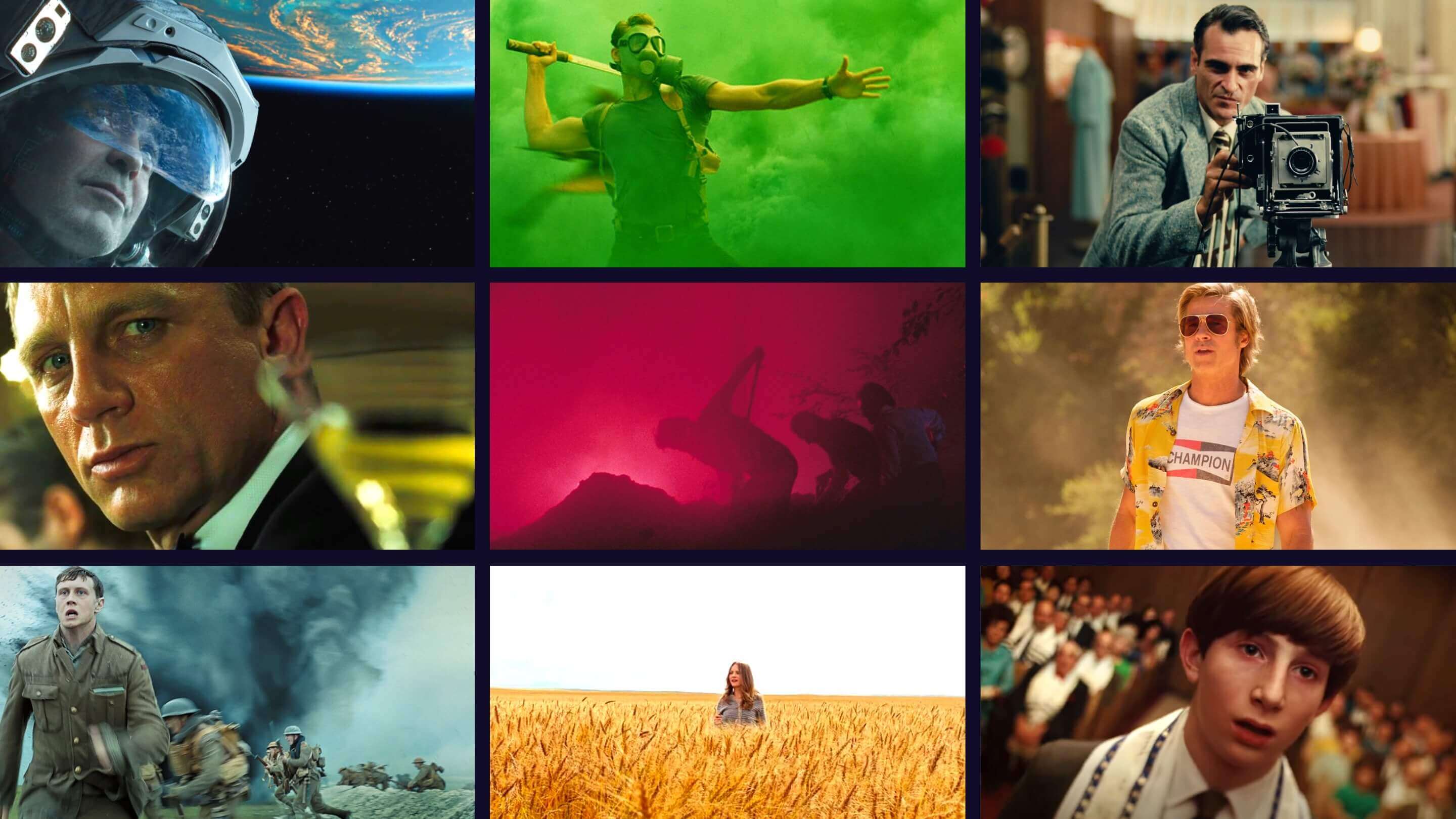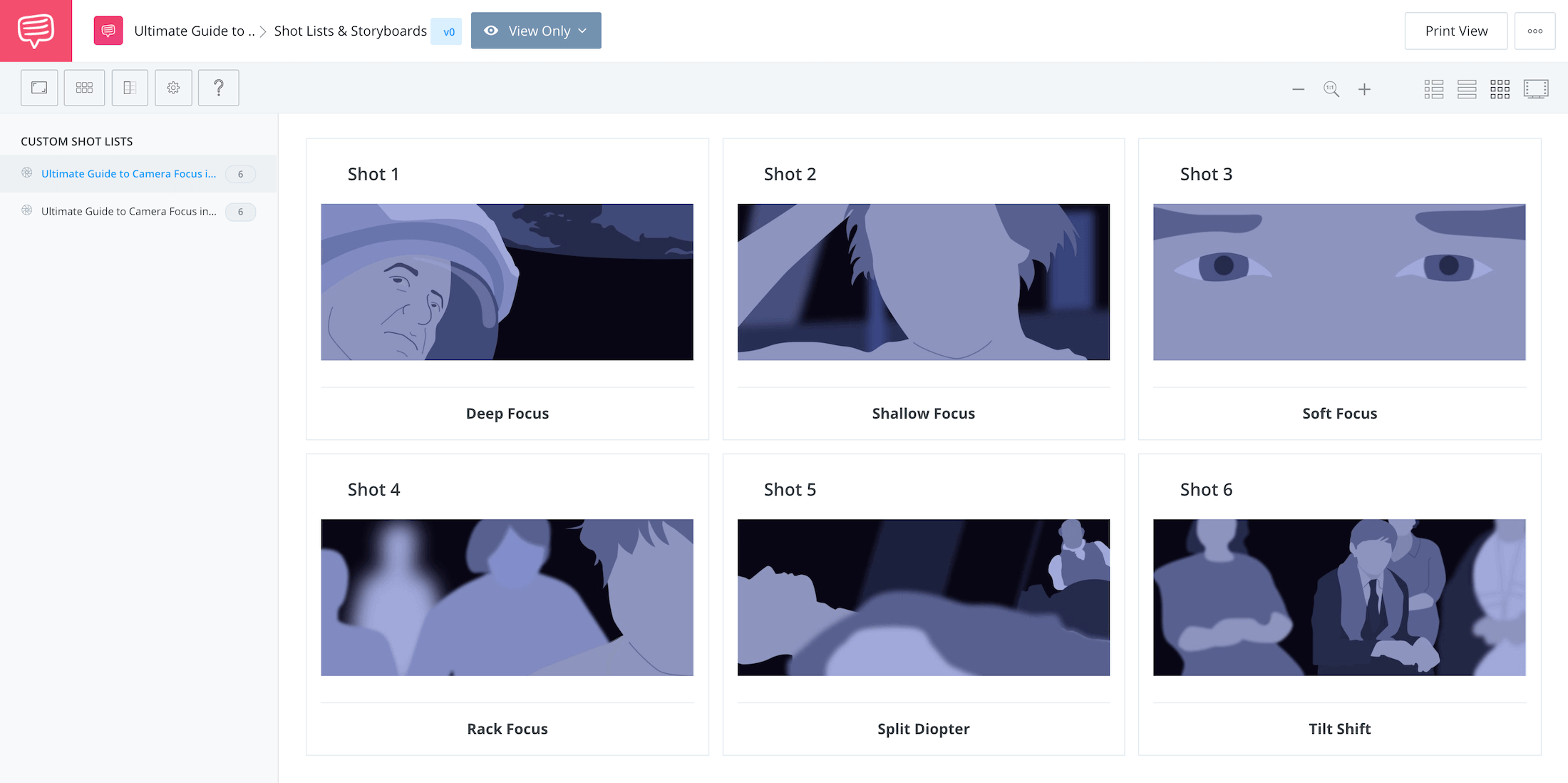Camera focus is more than just making sure your image is sharp and detailed. When you consider the storytelling value of shallow focus or how a rack focus can guide the eye, a whole new world opens up. Directors and cinematographers can manipulate the depth of field in film or photography for a variety of purposes. As you complete your next shot list, don’t forget this vital aspect of image making. Today, we’re going to review the different types of camera focus, how they contribute to visual storytelling, and we’ll look at some iconic examples.
Camera Focus
Overview on camera focus
When you start creating a shot list, there are certain considerations that come naturally and immediately. Shot size, camera framing, camera angles, and camera movement certainly are important. But there is one consideration that often gets overlooked: camera focus.
Depth of field can have a massive impact on the overall visual storytelling of each shot. So, let's take a minute to look at the different types of camera focus in film and how each can bring that extra layer of meaning to your shot list.
One aspect of achieving different effects with depth of field relies on a camera's aperture setting. Here's a breakdown of how aperture works.
What is Aperture? • Subscribe on YouTube
To get us started, we've collected six different types of camera focus in our StudioBinder storyboard. We included the silhouettes of each type of focus. Can you name the movies they're from?
Follow the image link to explore the shot list in detail, switch pages to see the actual shots, and download the storyboard for reference.
Types of Camera Focus in Film • Shotlisted in StudioBinder
Now that we have a basic overview of the different types of camera focus in film, let's review them individually. We'll start with the basics and move onto more advanced ways to use focal length to make more dynamic and meaningful shots.
Deep Depth of Field
Deep focus
Deep focus is when you want the audience to be able to see everything at once. Maybe this includes a wide angle of mountains in the distance, or objects in the foreground and background simultaneously. This is when you'll need a deep depth of field.
To achieve this, you'll need to understand what types of camera lenses to use and have a grasp on how aperture works. Here's an example of deep focus with one of the most iconic shots in cinema history.
In this moment from Citizen Kane, pay attention to how everything in the foreground, middle ground, and background stay in focus — and the various stories each plane of action contains.
Citizen Kane set the bar for excellence in deep focus cinematography
One of the benefits of using deep focus, as seen in these shots from Citizen Kane, is the ability to camera movement to create dynamic frame compositions. This allows the blocking and staging to diminish the need for cutting between individual shots.
Learn more about Deep Focus Shots →
Shallow Depth of Field
Shallow focus
In other cases, you might want to isolate a subject in the frame with a shallow depth of field. This is a great way to focus on something in particular without needing a close-up or extreme close-up.
One filmmaker who used shallow focus to great effect is Steven Soderbergh in his film Contagion. As the world erupts into chaos around our main characters, the shallow focus keeps us locked into their individual stories. Here's a video breakdown of how this is done.
Shallow Focus in Contagion • Subscribe on YouTube
When you look at shallow focus shots, pay attention to how naturally your eye follows and remains on whatever is in focus. This is a great way to direct the audience to what's important. Without shallow focus, you run the risk of them not noticing what you hope they notice.
Learn more about Shallow Focus Shots →
Soft Focus Photography
Soft focus
If deep depth of field keeps everything we see sharp, soft focus keeps nothing in focus. The entire frame is "soft," with a slight blur or glow around your subjects. Soft focus shots require either special lenses that have this "defect" or with a filter — they used to stretch nylons across or wipe vaseline on the lens in the old days.
The end effect of soft focus is to give shots a dreamy or slightly unreal quality. That's why we see them so often in dream sequences or memories — a visual cue that separates the scene from "now" or "reality."
Here's a great example from one of the best horror movies, Brian De Palma's Carrie. This is ending of the film so there's a SPOILER ALERT in effect. Notice the haze in the air and the glow from Sue's white dress.
Soft Focus in Carrie
You can see how just a slight adjustment to soft focus gives a scene an entirely new context. Granted, soft focus is a bit old-fashioned but it's just one of many cinematography techniques that packs a punch.
Rack Focus Shot
Rack focus
We've already covered shallow focus but we can take that technique a step further. When you want to shift the focal plane from foreground to background, or vice versa, the rack focus shot is ideal.
By adjusting the focal length of the lens, you can direct the audiences' attention even more. Shifting focus from one subject to another can also forego the need to cut between two shots. This has a practical benefit (saving time on set) but it also helps keep the audience engaged.
Here's our breakdown of how rack focus shots are used, with a look at Daniel Craig's first appearance as James Bond in Casino Royale.
Rack Focus Explained • Subscribe on YouTube
It should be clear that keeping the action in a single shot, with a rack focus, can be a really effective tool in visual storytelling. It keeps the shot dynamic and it gives the audience a direct connection to what's happening. Remember the rack focus when you're shot listing — it's a time saver on set and it just might be ideal for the scene.
Learn more about Rack Focus Shots →
Split Focus Diopter
Split diopter
A split diopter lens is a fascinating piece of equipment. Essentially, it creates two separate shallow focal planes in a single shot. This means something in the foreground can be in shallow focus, as can something else in the background. But why wouldn't you just use deep focus or rack focus between the two subjects?
Deep focus might leave too much to chance — you have to hope that the audience pays attention to what's important. And a rack focus can't keep both subjects in focus at the same time. In these moments, the best option is the split diopter.
Quentin Tarantino is a big fan of the split diopter lens. You can find these shots in many of Tarantino's best movies like Pulp Fiction and The Hateful Eight. Here's a quick explanation behind the split diopter shot.
How a Split Diopter Lens Works
The trouble with the split diopter is that is produces shots that are "impossible." In other words, our eyes can't create their own split focus image, it's unnatural. So, when we see it in a film, you run the risk of pulling the audience out of the movie.
Learn more about Split Diopter Shots →
Tilt Shift Photography
Tilt shift
Of the various types of camera focus in film, the tilt shift is perhaps the most radical. Normally, a camera lens is aligned directly with the camera's sensor. With a tilt shift lens, the lens can be either tilted vertically or shifted horizontally in relation to the sensor.
These lenses can be used to capture natural-looking images, such as panoramic landscapes. Or they can be used to make an entire city look like a toy model. Here's a compilation of tilt shift shots to give you an idea of how this works.
Tilt Shift Coachella
Similar to the split diopter, tilt shift shots provide an unnatural perspective. In other words, if you're thinking of adding a tilt shift shot like this into your shot list, it better be for a good reason.
Learn more about Tilt Shift Shots →
Related Posts
UP NEXT
The Essential Guide to Depth of Field
We've covered many types of camera focus in film and they all have one thing in common: depth of field. When you understand how this works, your ability to choose which type of camera focus becomes a snap. We'll cover the science behind depth of field and answer some big questions like "what is the circle of confusion" and the role of camera sensor size.
Up Next: Essential Guide to DoF →
Showcase your vision with elegant shot lists and storyboards.
Create robust and customizable shot lists. Upload images to make storyboards and slideshows.

